Determination of Annual Plasma Hormone Levels Associated with Reproduction in Long-Day Breeding Domestic Geese
Abstract
Simple Summary
Abstract
1. Introduction
2. Materials and Methods
2.1. Experimental Birds and Management
2.2. Measurement Parameters
2.3. Hormone Analysis
2.4. Statistical Analyses
3. Results
3.1. Reproduction Results
3.2. Plasma Concentration of Hormones in Ganders and Female Geese
3.2.1. PRL Concentration
3.2.2. Thyroid Hormones Concentrations—T3 and T4
T3 Concentration
T4 Concentration
3.2.3. Gonadal Steroid Hormones Concentration—T, E2, P4
T Concentration
P4 Concentration
E2 Concentration
3.3. Coefficients of Correlation between Hormone Concentrations
4. Discussion
5. Conclusions
Author Contributions
Funding
Institutional Review Board Statement
Informed Consent Statement
Data Availability Statement
Conflicts of Interest
References
- Sharp, P.J. Photoperiodic regulation of seasonal breeding in birds. Ann. N. Y. Acad. Sci. 2005, 1040, 189–199. [Google Scholar] [CrossRef]
- Ubuka, T.; Bentley, G.E.; Tsutsui, K. Neuroendocrine regulation of gonadotropin secretion in seasonally breeding birds. Front. Neurosci. 2013, 7, 1–38. [Google Scholar] [CrossRef]
- Dawson, A. The effect of latitude on photoperiodic control of gonadal maturation, regression and molt in birds. Gen. Comp. Endocrinol. 2013, 190, 129–133. [Google Scholar] [CrossRef]
- Guh, Y.J.; Tamai, T.K.; Yoshimura, T. The underlying mechanisms of vertebrate seasonal reproduction. Proc. Jpn. Acad. Ser. B Phys. Biol. Sci. 2019, 95, 343–357. [Google Scholar] [CrossRef] [PubMed]
- Yasuo, S.; Watanabe, M.; Nakao, N.; Takagi, T.; Follett, B.K.; Ebihara, S.; Yoshimura, T. The reciprocal switching of two thyroid hormone–activating and –inactivating enzyme genes is involved in the photoperiodic gonadal response of Japanese quail. Endocrinology 2005, 146, 2551–2554. [Google Scholar] [CrossRef]
- Dawson, A.; Sharp, P.J. Seasonal changes in concentrations of plasma LH and prolactin associated with the advance in the development of photorefractoriness and molt by high temperature in the starling. Gen. Comp. Endocrinol. 2010, 167, 122–127. [Google Scholar] [CrossRef] [PubMed]
- Peczely, P.; Bogenfurst, F.; Kulcsar, M.; Polgar, B. Role of gonadal and adrenal steroids and thyroid hormones in the regulation of molting in domestic goose. Acta. Biol. Hung. 2011, 62, 1–21. [Google Scholar] [CrossRef] [PubMed]
- Shi, Z.D.; Tian, Y.; Wu, W.; Wang, Z. Controlling reproductive seasonality in the geese: A review. Worlds Poult. Sci. J. 2008, 64, 343–355. [Google Scholar] [CrossRef]
- Puchajda-Skowrońska, H. Breeding and husbandry in geese. In Breeding and Husbandry of Poultry; Jankowski, J., Ed.; PWRiL: Warsaw, Poland, 2012; pp. 355–377. (In Polish) [Google Scholar]
- Biesiada-Drzazga, B.; Banaszewska, D.; Charuta, A.; Koncerewicz, A. Influence of age on egg characteristics and reproduction features of Koluda® white geese. Europ. Poult. Sci. 2016, 80, 1612–9199. [Google Scholar] [CrossRef]
- Gumułka, M.; Rozenboim, I. Mating activity of domestic geese ganders (Anser anser f. domesticus) during breeding period in relation to age, testosterone and thyroid hormones. Anim. Reprod. Sci. 2013, 142, 183–190. [Google Scholar] [CrossRef]
- Hirschenhauser, K.; Möstl, E.; Péczely, P.; Wallner, B.; Dittami, J.; Kotrschal, K. Seasonal relationships between plasma and fecal testosterone in response to GnRH in domestic ganders. Gen. Comp. Endocrinol. 2000, 118, 262–272. [Google Scholar] [CrossRef]
- Peczely, P.; el Halawani, M.E.; Hargitai, C.; Mezes, M.; Forgo, V.; Janosi, S. The photorefractoriness in domestic goose: Effect of gonads and thyroid on the development of postbreeding prolactinemia. Acta. Biol. Hung. 1993, 44, 329–352. [Google Scholar] [PubMed]
- Yang, H.M.; Wang, Y.; Wang, Z.Y.; Wang, X.X. Seasonal and photoperiodic regulation of reproductive hormones and related genes in Yangzhou geese. Poult. Sci. 2017, 96, 486–490. [Google Scholar] [CrossRef] [PubMed]
- Zhu, H.; Shao, X.; Chen, Z.; Wei, C.; Lei, M.; Ying, S.; Yu, J.; Shi, Z. Induction of out–of–season egg laying by artificial photoperiod in Yangzhou geese and the associated endocrine and molecular regulation mechanisms. Anim. Reprod. Sci. 2017, 180, 127–136. [Google Scholar] [CrossRef]
- Zhu, H.; Chen, Z.; Yu, J.; Wei, C.; Dai, Z.; Shi, Z. Reproductive axis gene regulation during photostimulation and photorefractoriness in Yangzhou goose ganders. Front. Zool. 2017, 14, 1–15. [Google Scholar] [CrossRef]
- Shi, Z.D.; Huang, Y.M.; Liu, Z.; Liu, Y.; Li, X.W.; Proudman, J.A.; Yu, R.C. Seasonal and photoperiodic regulation of secretion of hormones associated with reproduction in Magang goose ganders. Dom. Anim. Endocrinol. 2007, 32, 190–200. [Google Scholar] [CrossRef]
- Huang, Y.M.; Shi, Z.D.; Liu, Z.; Liu, Y.; Li, X.W. Endocrine regulations of reproductive seasonality, follicular development and incubation in Magang geese. Anim. Reprod. Sci. 2008, 104, 344–358. [Google Scholar] [CrossRef] [PubMed]
- Zhao, X.Z.; Gao, G.L.; Wang, H.W.; Li, Q.; Zhang, K.S.; Zhong, H.; Wang, Q.G. Effect of photoperiod on serum hormone concentrations during the annual reproductive cycle in geese. Genet. Mol. Res. 2017, 16, 2–8. [Google Scholar] [CrossRef]
- Hirschenhauser, K.; Weiß, B.M.; Haberl, W.; Möstl, E.; Kotrschal, K. Female androgen patterns and within-pair testosterone compatibility in domestic geese (Anser domesticus). Gen. Comp. Endocrinol. 2010, 165, 195–203. [Google Scholar] [CrossRef] [PubMed]
- Hirschenhauser, K. Testosterone and partner compatibility: Evidence and emerging questions. J. Ethol. 2012, 118, 799–811. [Google Scholar] [CrossRef]
- Hirschenhauser, K.; Möstl, E.; Kotrschal, K. Within-pair testosterone co–variation and reproductive output in greylag geese (Anser anser). Ibis 1999, 141, 577–586. [Google Scholar] [CrossRef]
- Angelier, F.; Wingfield, J.C.; Tartu, S.; Chastel, O. Does prolactin mediate parental and life–history decisions in response to environmental conditions in birds? A review. Horm. Behav. 2016, 77, 18–29. [Google Scholar] [CrossRef] [PubMed]
- Rabsztyn, A. Zatorska Goose Population as a Part of the Polish Genetic Resources of Waterfowl. Habilitation Thesis, University of Agriculture in Cracow, Cracow, Poland, 2006. (In Polish). [Google Scholar]
- World Watch List for Domestic Animal Diversity, 3rd ed.; Scherf, B.D., Ed.; Food and Agriculture Organization of the United Nations: Rome, Italy, 2000; pp. 351–373. [Google Scholar]
- Gumułka, M.; Rozenboim, I. Breeding period–associated changes in semen quality, concentrations of LH, PRL, gonadal steroid and thyroid hormones in domestic goose ganders (Anser anser f. domesticus). Anim. Reprod. Sci. 2015, 154, 166–175. [Google Scholar] [CrossRef] [PubMed]
- Gumułka, M.; Rozenboim, I. Effect of breeding stage and photoperiod on gonadal and serotonergic axes in domestic ganders. Theriogenology 2015, 84, 1332–1341. [Google Scholar] [CrossRef]
- Nash, J.P.; Davail-Cuisset, B.; Bhattacharyya, S.; Suter, H.C.; Le Menn, F.; Kime, D.E. An enzyme linked immunosorbant assay (ELISA) for testosterone, estradiol, and 17,20β–dihydroxy–4-pregenen–3–one using acetylcholinesterase as tracer: Application to measurement of diel patterns in rainbow trout (Oncorhynchus mykiss). Fish Physiol. Biochem. 2000, 22, 355–363. [Google Scholar] [CrossRef]
- Rochester, J.R.; Heiblum, R.; Rozenboim, I.; Millam, J.R. Post-hatch oral estrogen exposure reduces oviduct and egg mass and alters nest–building behavior in adult zebra finches (Taeniopygia guttata). Physiol. Behav. 2008, 95, 370–380. [Google Scholar] [CrossRef]
- Gumułka, M.; Rozenboim, I. Effect of the age of ganders on reproductive behavior and fertility in a competitive mating structure. Ann. Anim. Sci. 2017, 17, 733–746. [Google Scholar] [CrossRef]
- Rozenboim, I.; Mobarky, N.; Heiblum, R.; Chaiseha, Y.; Kang, S.W.; Biran, I.; Rosenstrauch, A.; Sklan, D.; El Halawani, M.E. The role of prolactin in reproductive failure associated with heat stress in the domestic turkey. Biol. Reprod. 2004, 71, 1208–1213. [Google Scholar] [CrossRef] [PubMed]
- Gumułka, M.; Hrabia, A.; Avital-Cohen, N.; Andres, K.; Rozenboim, I. The effect of parachlorophenylalanine treatment on gonadal and lactotrophic axes activity in native Polish crested chickens stimulated to broodiness. Poult. Sci. 2020, 99, 2708–2717. [Google Scholar] [CrossRef]
- Avital-Cohen, N.; Heiblum, R.; Rosenstrauch, A.; Chaiseha, Y.; Mobarkey, N.; Gumułka, M.; Rozenboim, I. Role of the serotonergic axis in the reproductive failure associated with aging broiler breeder roosters. Domest. Anim. Endocrinol. 2015, 53, 42–51. [Google Scholar] [CrossRef] [PubMed]
- Bartman, J.; Zaguri, S.; Avital-Cohen, N.; Dishon, L.; Druyan, S.; Gumułka, M.; Rozenboim, I. Targeted differential illumination improves reproductive traits of broiler breeder males. Poult. Sci. 2021, 100, 101109. [Google Scholar] [CrossRef]
- Yao, Y.; Yang, Y.Z.; Gu, T.T.; Cao, Z.F.; Zhao, W.M.; Qin, H.R.; Xu, Q.; Chen, G.H. Comparison of the broody behavior characteristics of different breeds of geese. Poult. Sci. 2019, 98, 5226–5233. [Google Scholar] [CrossRef]
- Sharp, P.J.; Blache, D. A neuroendocrine model for prolactin as key mediator of seasonal breeding in birds under long–and short– day photoperiods. Can. J. Physiol. Pharm. 2003, 81, 350–358. [Google Scholar] [CrossRef] [PubMed]
- Dawson, A.; Perrins, C.M.; Sharp, P.J.; Wheeler, D.; Groves, S. The involvement of prolactin in avian molt: The effects of gender and breeding success on the timing of molt in Mute swans (Cygnus olor). Gen. Comp. Endocrinol. 2009, 161, 267–270. [Google Scholar] [CrossRef] [PubMed][Green Version]
- Ma, R.; Jiang, D.; Chen, Z.; Kang, B. Evidence of a role for prolactin as regulators of ovarian follicular development in goose. Electron. J. Biotechn. 2015, 18, 389–392. [Google Scholar] [CrossRef]
- Avital-Cohen, N.; Heiblum, R.; Argov, N.; Rosenstrauch, A.; Chaiseha, Y.; Mobarkey, N.; Rozenboim, I. The effect of active immunization against vasoactive intestinal peptide (VIP) and inhibin on reproductive performance of aging White Leghorn roosters. Poult. Sci. 2012, 91, 161–174. [Google Scholar] [CrossRef]
- Sechman, A.; Paczoska–Eliasiewicz, H.; Rzasa, J.; Hrabia, A. Simultaneous determination of plasma ovarian and thyroid hormones during sexual maturation of the hen (Gallus domesticus). Folia Biol. 2000, 48, 7–12. [Google Scholar]
- Otsuka, R.; Machida, T.; Wada, M. Hormonal correlations at transition from reproduction to molting in an annual life cycle of Humboldt penguins (Spheniscus humboldti). Gen. Comp. Endocrinol. 2004, 135, 175–185. [Google Scholar] [CrossRef]
- Sechman, A.; Pawlowska, K.; Rzasa, J. Influence of triiodothyronine (T(3)) on secretion of steroids and thyroid hormone receptor expression in chicken ovarian follicles. Domest. Anim. Endocrinol. 2009, 37, 61–73. [Google Scholar] [CrossRef]
- Goymann, W.; Wingfield, J.C. Male-to-female testosterone ratios, dimorphism, and life history—what does it really tell us? Behav. Ecol. 2014, 25, 685–699. [Google Scholar] [CrossRef]
- Heifetz, E.M.; Rozenboim, I.; Soller, M.; Eitan, Y. Hormonal levels of estradiol, testosterone, and progesterone at entry into lay of year 1980 vs. 2000 broiler breeder females under fast and slow release from feed restriction. Poult. Sci. 2018, 97, 3728–3735. [Google Scholar] [CrossRef] [PubMed]
- Johnson, A.L. Reproduction in the Female. In Sturkie’s Avian Physiology, 6th ed.; Scanes, C., Ed.; Academic Press: Cambridge, MA, USA, 2014; pp. 635–665. [Google Scholar]
- Rangel, P.L.; Gutierrez, C.G. Reproduction in hens: Is testosterone necessary for the ovulatory process? Gen. Comp. Endocrinol. 2014, 203, 250–261. [Google Scholar] [CrossRef] [PubMed]
- Proszkowiec-Weglarz, M.; Rzasa, J.; Słomczyńska, M.; Paczoska-Eliasiewicz, H. Steroidogenic activity of chicken ovary during pause in egg laying. Reprod. Biol. 2005, 5, 205–225. [Google Scholar] [PubMed]
- Leska, A.; Kiezun, J.; Kaminska, B.; Dusza, L. Estradiol concentration and the expression of estrogen receptors in the testes of the domestic goose (Anser anser f. domestica) during the annual reproductive cycle. Dom. Anim. Endocrinol. 2015, 51, 96–104. [Google Scholar] [CrossRef]
- David, C.G.; Reddy, I.J.; Singh, K. Oviposition patterns associated with prolactin concentration in domestic chicken (Gallus domesticus). Asian Australas. J. Anim. Sci. 2003, 16, 1565–1571. [Google Scholar] [CrossRef]
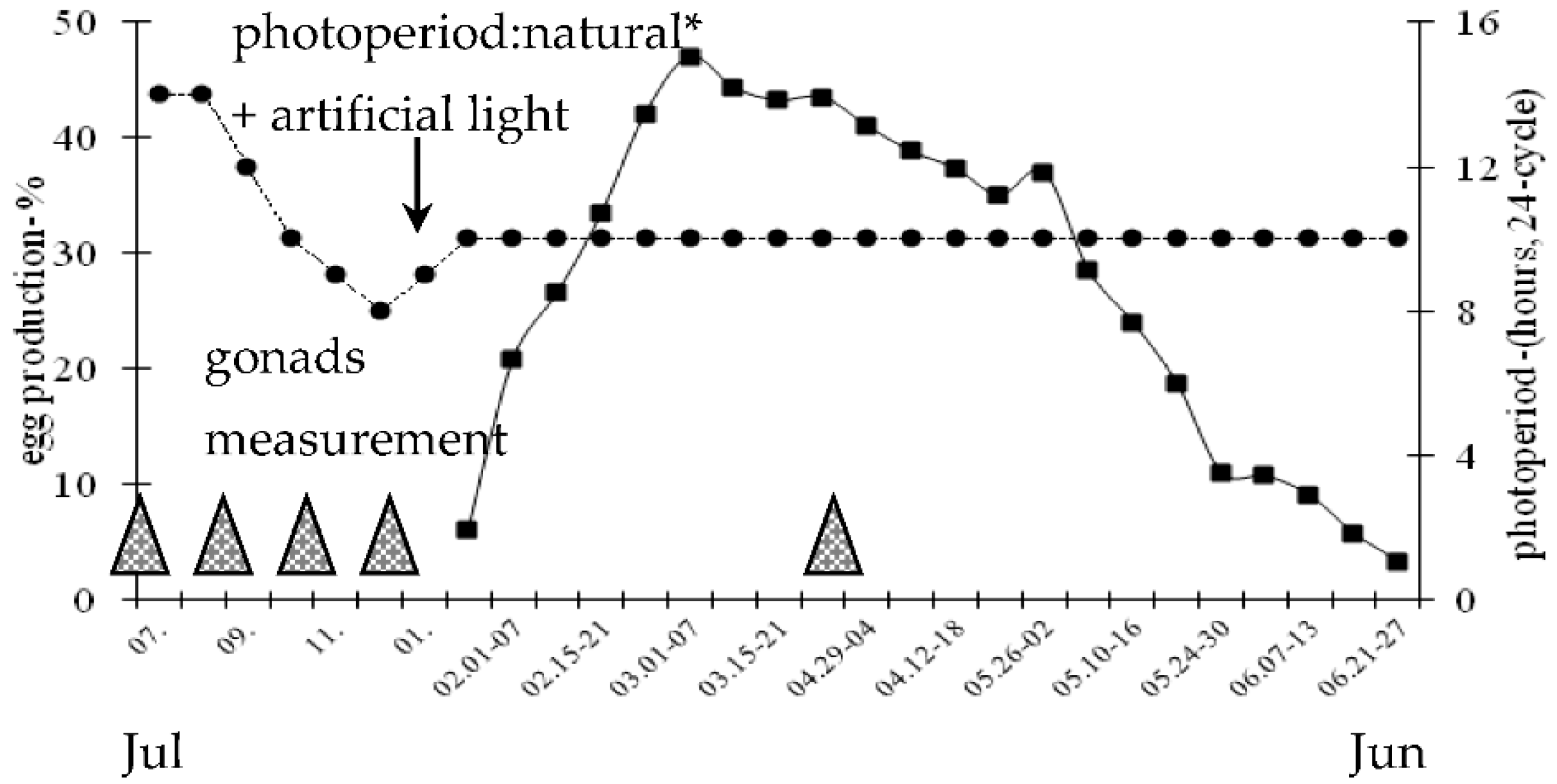
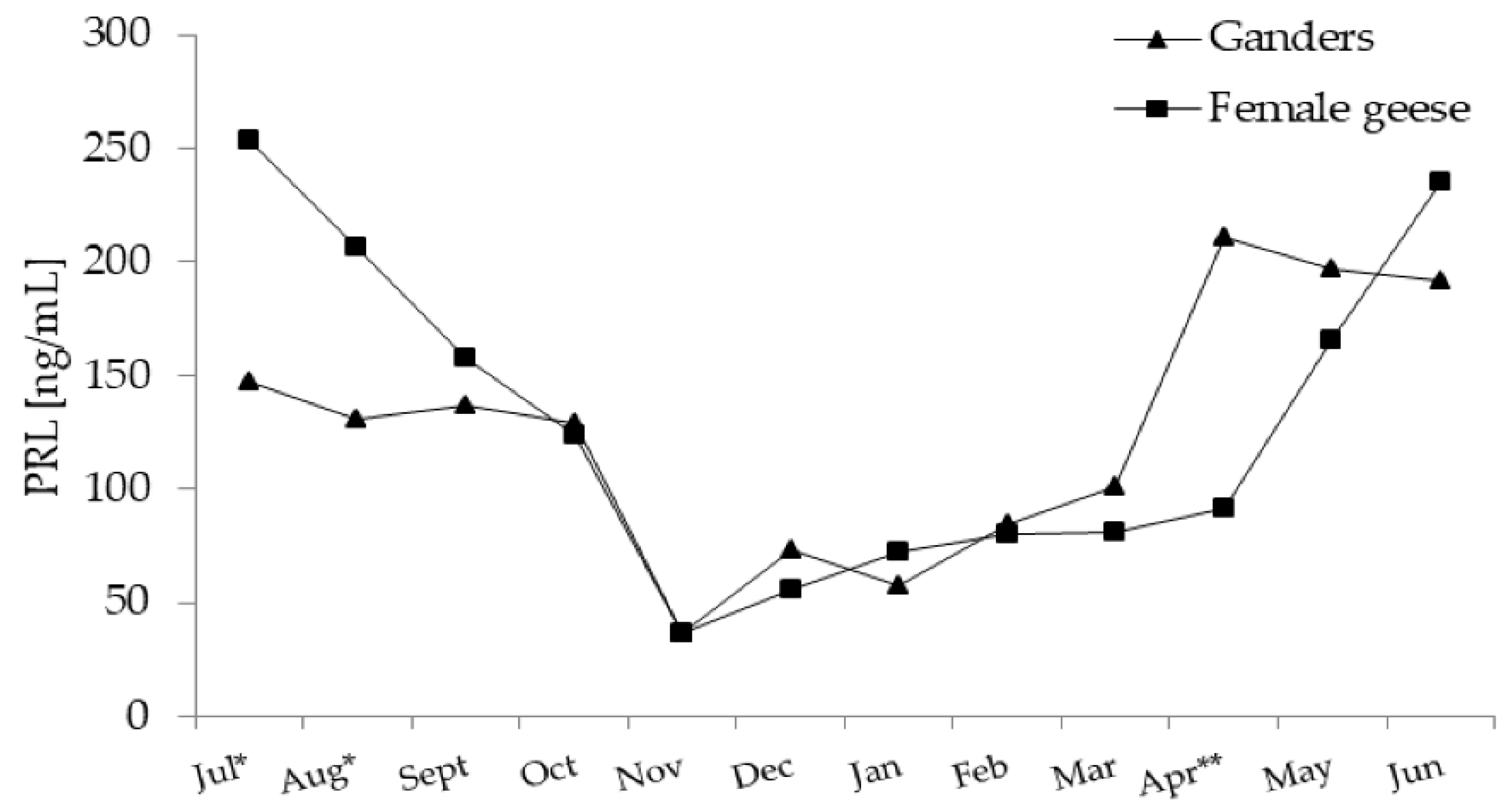
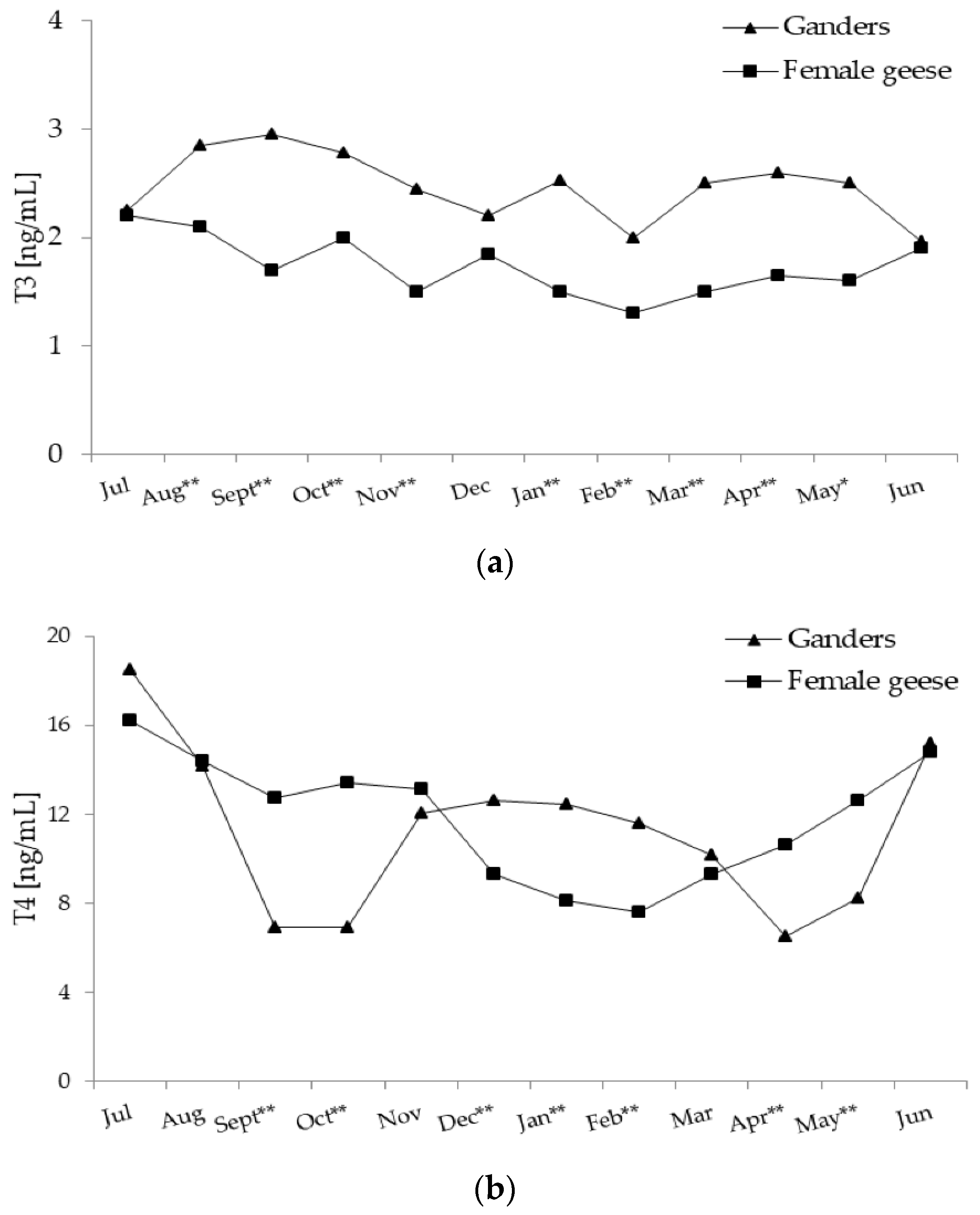
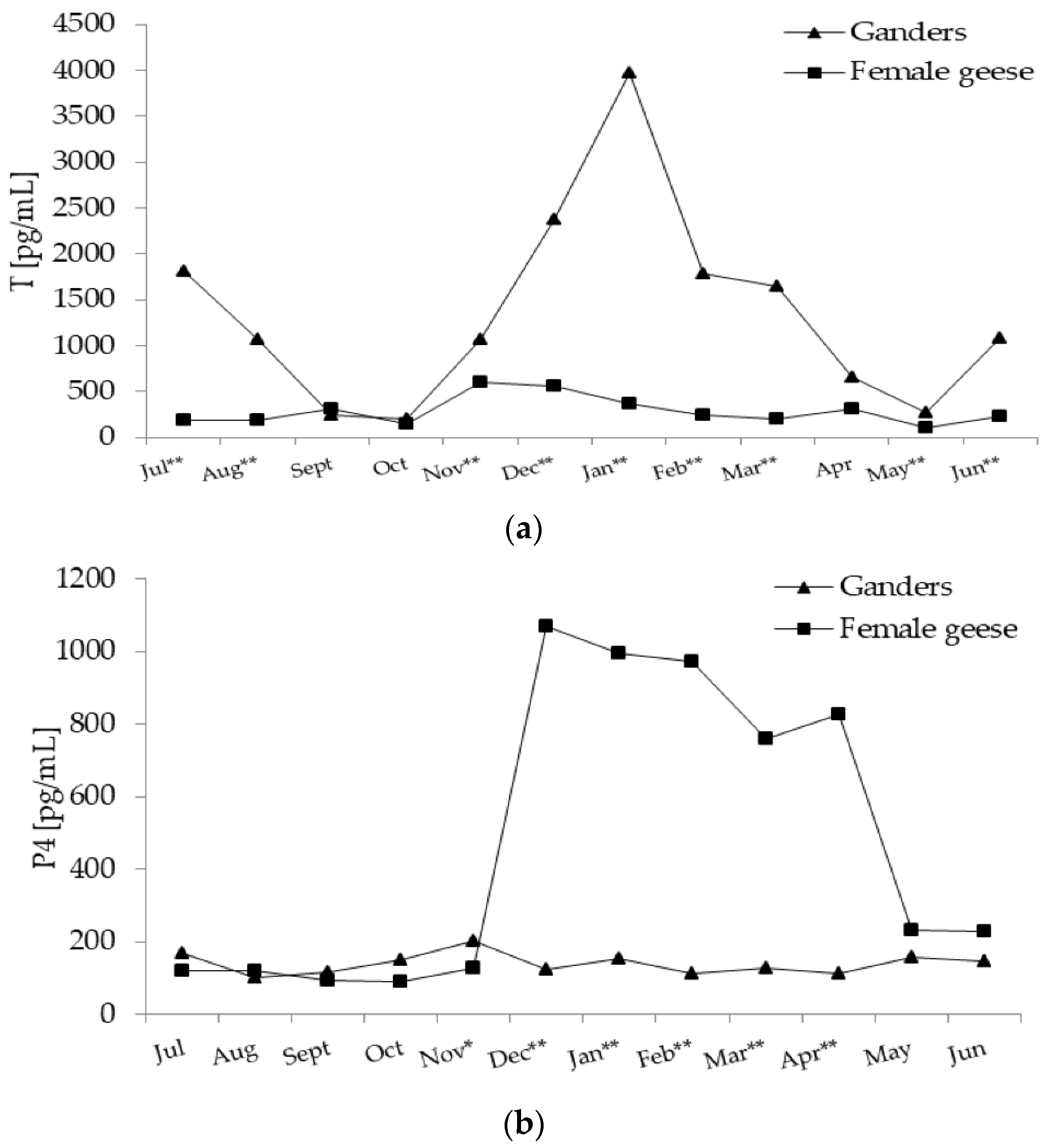
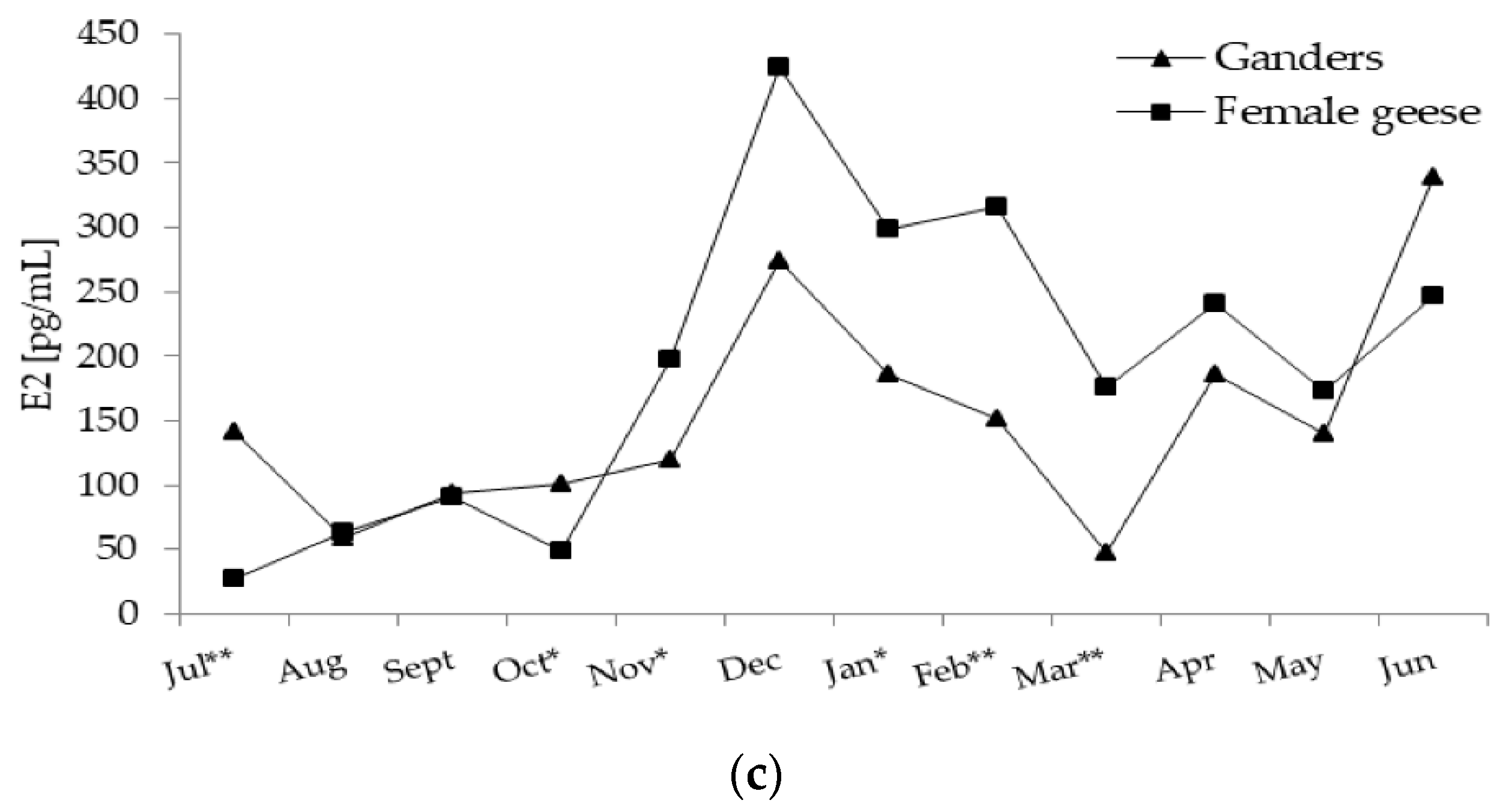
| Stage | Body Weight (g) | Testes | ||||||||||||
|---|---|---|---|---|---|---|---|---|---|---|---|---|---|---|
| Right | Left | Right | Left | Right | Left | |||||||||
| Weight (g) | Major Axis (mm) | Minor Axis (mm) | ||||||||||||
| Post-breeding (July) * | 6231 ab | 380 | 4.0 ab | 2.2 | 4.9 ab | 1.2 | 24.9 ab | 2.1 | 28.7 ab | 3.3 | 19.0 b | 3.8 | 19.7 ab | 2.2 |
| Non-breeding (September) | 4970 b | 302 | 1.7 a | 0.7 | 1.7 a | 1.3 | 16.8 a | 1.1 | 18.6 a | 1.6 | 8.1 a | 1.6 | 9.1 a | 3.6 |
| Pre-breeding (November) | 4891 b | 955 | 3.8 ab | 1.8 | 7.2 ab | 3.7 | 22.8 ab | 1.1 | 29.8 ab | 2.1 | 14.5 ab | 0.6 | 19.5 ab | 1.9 |
| Onset of laying (January) | 6597 a | 174 | 6.8 b | 2.0 | 9.8 b | 2.7 | 27.0 b | 5.5 | 28.7 b | 3.5 | 18.9 b | 1.7 | 24.0 b | 1.1 |
| Breeding–laying (April) | 6235 ab | 734 | 4.3 ab | 0.4 | 8.2 b | 2.7 | 28.2 b | 0.8 | 33.2 b | 2.0 | 17.0 ab | 2.6 | 24.5 b | 2.0 |
| Stage | Body Weight (g) | Ovary | Oviduct | |||||||||||
|---|---|---|---|---|---|---|---|---|---|---|---|---|---|---|
| Weight (g) | Follicles | Weight (g) | Lenght (cm) | |||||||||||
| LWF: 3–8 mm (n) | SYF: 9–18 mm (n) | LYF: 19–64 mm (n) | ||||||||||||
| Post-breeding (July) * | 5405 ab | 398 | 7.5 ac | 1.3 | 7 a | 7 | - | - | - | - | 16.6 ab | 2.1 | 50.0 abc | 9.0 |
| Non-breeding (September) | 4870 b | 300 | 1.1 a | 0.4 | 25 ab | 8 | - | - | - | - | 9.3 a | 3.7 | 29.0 a | 6.5 |
| Pre-breeding (November) | 4770 b | 700 | 1.5 a | 0.4 | 31 ab | 4 | - | - | - | - | 9.3 a | 2.4 | 33.0 ab | 6.0 |
| Onset of laying (January) | 5698 a | 375 | 239.5 b | 32.0 | 39 b | 8 | 8 a | 1 | 8 a | 1 | 78.9 b | 14.4 | 114.5 c | 4.0 |
| Breeding–laying (April) | 5709 a | 662 | 127.8 bc | 5.6 | 33 b | 8 | 6 a | 5 | 5 b | 1 | 93.5 b | 5.1 | 111.5 bc | 1.5 |
| Ganders | |||||||
|---|---|---|---|---|---|---|---|
| PRL [ng/mL] | T3 [ng/mL] | T4 [ng/mL] | T [pg/mL] | P4 [pg/mL] | E2 [pg/mL] | ||
| Female geese | PRL [ng/mL] | - | rp = −0.133 * | rp = −0.129 * | rp = −0.382 *** | rp = −0.116 | rp = 0.020 |
| T3 [ng/mL] | rp = −0.117 * | - | rp = −0.228 *** | rp = −0.032 | rp = −0.122 | rp = −0.039 | |
| T4 [ng/mL] | rp = 0.244 *** | rp = 0.013 | - | rp = 0.436 *** | rp = 0.230 *** | rp = 0.105 | |
| T [pg/mL] | rp = −0.334 *** | rp = 0.107 | rp = −0.213 *** | - | rp = 0.164 ** | rp = 0.141 * | |
| P4 [pg/mL] | rp = −0.143 ** | rp = 0.073 | rp = 0.129 * | rp = 0.233 *** | - | rp = 0.048 | |
| E2 [pg/mL] | rp = −0.409 *** | rp = 0.108 | rp = −0.118 * | rp = 0.284 *** | rp = 0.445 *** | - | |
Publisher’s Note: MDPI stays neutral with regard to jurisdictional claims in published maps and institutional affiliations. |
© 2021 by the authors. Licensee MDPI, Basel, Switzerland. This article is an open access article distributed under the terms and conditions of the Creative Commons Attribution (CC BY) license (https://creativecommons.org/licenses/by/4.0/).
Share and Cite
Gumułka, M.; Avital-Cohen, N.; Rozenboim, I. Determination of Annual Plasma Hormone Levels Associated with Reproduction in Long-Day Breeding Domestic Geese. Animals 2021, 11, 2363. https://doi.org/10.3390/ani11082363
Gumułka M, Avital-Cohen N, Rozenboim I. Determination of Annual Plasma Hormone Levels Associated with Reproduction in Long-Day Breeding Domestic Geese. Animals. 2021; 11(8):2363. https://doi.org/10.3390/ani11082363
Chicago/Turabian StyleGumułka, Małgorzata, Nataly Avital-Cohen, and Israel Rozenboim. 2021. "Determination of Annual Plasma Hormone Levels Associated with Reproduction in Long-Day Breeding Domestic Geese" Animals 11, no. 8: 2363. https://doi.org/10.3390/ani11082363
APA StyleGumułka, M., Avital-Cohen, N., & Rozenboim, I. (2021). Determination of Annual Plasma Hormone Levels Associated with Reproduction in Long-Day Breeding Domestic Geese. Animals, 11(8), 2363. https://doi.org/10.3390/ani11082363






